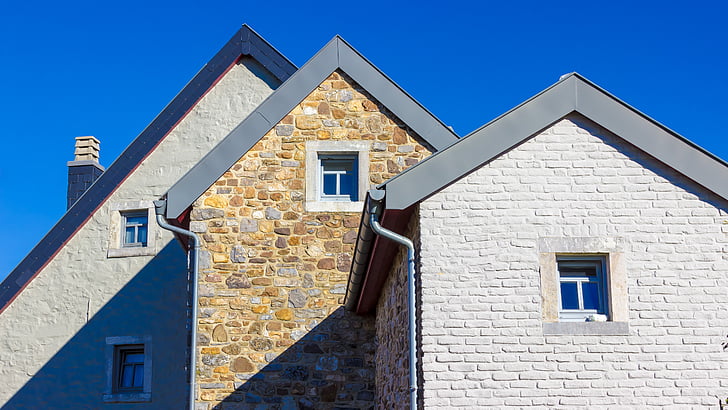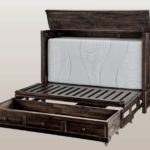You have a lot of options when it comes to natural Stone for house exterior Painting. Natural stone is widely employed because of its many appealing characteristics and adaptability in design. The top ten natural stone varieties utilised for exterior house painting will be covered in this article, along with the benefits and drawbacks of each.
Not only will we advise you on the best course of action for your project, but we will also show you how to paint your natural stone. We’ll cover some painted stone maintenance advice to ensure it looks fantastic for many years.
Contents
Types of natural stone
Natural stone is a well-liked material for painting external walls of homes in order to create distinctive, lovely designs. Naturally occurring stone has many benefits and applications. We’ll examine the three most popular natural stone varieties—slate, sandstone, and limestone—that are utilized for exterior home painting in this post.
Painting natural stone can change a number of its characteristics, including its texture, absorbency, and porosity. While choosing the ideal stone for your project, Understanding these traits is essential. Calcium carbonate is a sedimentary rock with a high porosity level that makes up the majority of limestone. The bulk of the clastic sedimentary rock known as sandstone is composed of low-porosity sand-sized particles. Slate is a metamorphic rock with small granules that absorb more water than other stones.
While making your choice, consider how these elements may affect how your painted stone will seem in the end. The porosity and absorbency of paint control how quickly and well it sticks to a surface. When painting genuine stone, texture is a crucial factor in determining how well smooth finishes turn out.
Knowing how to maintain the beauty of your painted natural stone for years to come is essential. Gentle clothes and mild detergents should be part of everyone’s standard cleaning routine.
To prevent weather-related deterioration and discoloration from built-up dirt and debris, routine sealing treatments must be carried out. If you follow these simple steps, your painted natural stone will retain its beautiful appearance for years.
Advantages of natural stone for exterior painting
If you want a durable, weatherproof finish, painting a stone building is a great choice. Natural stone is a fantastic material option for any house restoration project since it comes in many forms, sizes, colors, and textures. It offers protection from the sun’s rays and is simple to maintain and clean.
Adding natural stone to the exterior of your home is another great way to make it stand out. Using their different forms and sizes, stones such as limestone, sandstone, and slate can generate eye-catching patterns and designs.
Natural stone could be painted for the desired impression instead of tiled floors or other costly alternatives. In addition, real stone paint can be used to give the exterior of a home a more premium look for very little money.
The preparation time for painting metal or wood siding, for example, is longer than that for painting real stone. Before painting, ensure the surface is clean and free of dirt and grime by giving it a good scrub with soap and water. After cleaning, a coat of primer should be applied before the painting begins.
Homeowners frequently choose natural stone paint due to its many benefits over other paints. Natural stones require little preparation before painting, are long-lasting, and require little upkeep so that the finished product will look fantastic for a very long time with little work on your side.
Preparation tips for painting with natural stone
- The façade of a property can be given additional personality and charm by painting over natural stone. However, careful forethought is required if the endeavour is to be successful. Choosing a glue compatible with the natural stone you plan to use is the first step.
- Making sure the glue you’re using is suitable for the stone you’re working with requires some preliminary investigation. Adhesives are required for several types of stone.
- If you’ve decided on a stone, the last step before applying adhesive is to give it a thorough washing. When you do this, you can rest assured that the bond will adhere well and that any dirt or dust has been removed.
- A base coating that resists moisture and the elements should be added to the stone as soon as it is dry. When this layer is dried, a sealer can be applied to it to prevent further damage from exposure to UV rays and other environmental risks, thus increasing its usable life and boosting its aesthetic appeal.
- Coated natural stone requires extra care to retain its shine throughout time. Washing it with some gentle soap and water will keep it looking great without the need for harsh chemicals or abrasive products. If you want to avoid leaving any scuff marks or scratches on your freshly painted stonework, try wearing gloves while you work.
- If homeowners follow these simple procedures, they may paint natural stone with the assurance that comes from knowing they have done everything necessary to guarantee the project will last for years without fading or chipping.
10 most popular stones for house exterior painting
- Many homeowners who decide to paint their exteriors do so in a natural stone colour. Properly sealed natural stone can retain its weatherproof sheen for up to 20 years. Numerous stones exist, each with its own set of advantages and uses. The best exterior house-painting stones are as follows.
- Limestone is mainly composed of magnesium and calcium carbonate, both found in sedimentary rocks. Its durability and strength make it a popular material for flooring and countertops. Because of its porous nature, limestone is ideally suited for use as an exterior home painting material.
- Sandstone is widely used for outdoor painting since it is affordable and has a smooth feel. It is highly resistant to water, making it a great option for places with extreme climates or high humidity.
- Mica and quartzite in slate give it a unique appearance when used as an exterior wall covering. Because of its coarse surface, it can be used for mosaic and mural designs that would otherwise be too delicate.
- Among the many luxurious options for exterior wall materials, marble is a top pick. It can withstand harsh conditions, but only with regular care.
- Granite has been a building material for millennia because of its durability and resilience to weather effects. Granite continues to be a popular material for outdoor painting projects because of its distinctive colours, textures, and patterns.
- Travertine: Although categorised as a type of limestone, it differs slightly from limestone in a few minor waysPaint sticks to it more easily when applied externally because compared to other stones, it is assumed to be more permeable.
- Quartzite: This hardy metamorphic rock has proven to be incredibly impervious to environmental degradation throughout time. Because quartzite can tolerate extreme temperature changes without losing its painted colour, it is a material that performs well in outdoor environments.
- Because of its composition, comparable to granite but denser, basalt is a fantastic choice for exterior painting jobs where a lot of wear and tear is expected. The excessive humidity and salt spray that basalt is often exposed to can’t do any damage to it.
- Because it doesn’t need any maintenance after installation, bluestone is quickly becoming a popular choice among homeowners as an attractive alternative to natural stone. The blue-grey tones provide protection from the sun and rain while also giving a home’s exterior a sophisticated look over time.
- Since it is more affordable than natural stone, concrete replaces stone in many outdoor applications. Texturing, staining, and polishing are just a few concrete treatments possible. As a bonus, concrete can be styled to have an antique or contemporary appearance, depending on the designer’s intentions.
Conclusion: Most Popular natural Stone for house exterior Painting
A building’s outer stone walls are solid, impervious to the elements, and aesthetically beautiful. Because of its durability, strength, and versatility, stone is an excellent construction material. After proper cleaning, priming, and sealing with the appropriate adhesive, natural stone may retain its beautiful, long-lasting appearance. To keep the stone in pristine condition, routine sealing and washing are required.
Considering these benefits, it’s not hard to see why homeowners like painted natural stone so much. Many choices are available, whether you want a traditional or contemporary style. Thinking about the benefits, how about attempting to stone the exterior of your home? How happened? Let us know what you think by commenting on the blog article. For even more information and guidance, please go through our associated articles.











1 thought on “Most Popular natural Stone for house exterior Painting”